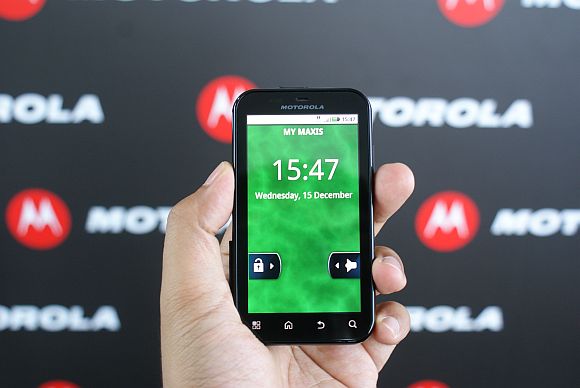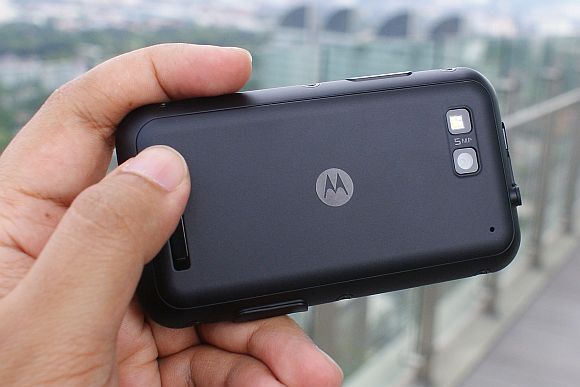
Like we’ve said before, we’re fans phones that can take a pounding and still comeback for more. There is something seriously cool about a rugged phone, some kind of magnetism that we can’t put out finger on. So naturally, when we found out that the Motorola Defy was going to be launched in Malaysia we were pretty stoked.
So we were at the launch today to get some some brief hands-on time with the Motorola Defy and here’s our first impression.
Overall design, feel and built-quality
What can we say about the Defy. For starters, it looks decidedly run-of-the-mill — candybar form factor with soft edges and a ruberised, soft-touch plastic casing — but that is not really an issue, it’s not ugly or odd looking, it’s just plain. You might not stand-out from the crowd with the staid all-black colour (US and EU Defys get a smart two tone white and black exterior which we think should be an option here) exterior but you can definitely rack up some major cool points when you calmly chuck the Defy into the pool at your next pool party only to fish it out and show your friends that the Defy is still able to make phone calls
The Motorola Defy is most probably the first rugged Android device in the market but unlike other dust- and water-proof phones before it, the Defy — erm — defies convention by not being bulky or heavy. Other than the bunch of Torx screws (seven on the outer casing, if you’re counting) littered all around the outer casing of the device and the rubber dust covers ensuring that the exposed microUSB and 3.5mm ports have a water-tight seal, the Defy feels and weighs just like any other smart phone out there. And that’s a good thing because you get a lot of protection without so much bulk added.
Comparing the Defy with some of the most svelte devices in the market in terms of thickness and weight — iPhone 4 9.3mm 137g, Samsung Galaxy S 9.9mm 118g, Nexus S 10.8mm 129g — the Defy at 13mm thick and 118g heavy, sits is comfortably average. For good measure, here’s the thickness and weight of the HTC Desire Z that features pop-out keyboard, 14mm 180g.
In terms of built quality, we can’t fault the Defy. The soft-touch rubber-like plastic feels good in the hand and looks like it can hold up to a lot of scuffs and drops for a long time to come.
Internals and user interface
The Defy runs Android 2.1 skinned with enhanced Motoblur which brings with it some useful improvements like a download manager that is smart enough to hold your large file uploads until it detects that you’re connected to a WiFi network. The option to turn the Defy into a 3G mobile router is also available as well as home screen widgets that you can resize to suit your needs.
Powering the Defy is an 800Mhz TI OMAP 361 processor with 512MB of RAM and 2GB of on board storage. Memory expansion comes in the form of microSD with the Defy capable of taking up to 32GB cards
Dominating the front of the Defy is a Gorilla Glass strengthened 3.7in capacitive touchscreen with a fairly high 854×480 pixel resolution. From what we’re gathered during our limited time with the Defy at the launch, the touchscreen accuracy and response of the is very good, the screen is also very and sharp despite not incorporating any fancy schmancy display technology like super AMOLED. Basically, no complaints here. It’s simple and it works and with Gorilla Glass protection you can bet that it’s pretty darn strong to boot.
The enhanced Motoblur skin looks to be one of the better integrated UIs to be installed on top of the Android OS to a point that it looks like a part of the OS rather than an add-on. Scrolling through the home screens and opening up websites reveals that it is also much optimised with the hardware and the Android 2.1 OS producing a snappy user interface.
This is not to say that we are fans of skinned Android devices but as far as those things go, the Defy with this enhanced Motoblur runs smooth and that’s a good thing. We can’t say we’d like it in the long run but from our hit-and-run test, it looks to be something we can get used to.
In terms of battery life, what can we say, we had a very short time to fiddle with the Defy but with a battery capacity of 1540mAh, we’re expected a pretty decent usage time between charges. A full-on test can help us verify this so here’s hoping we’ll get a review unit soon.
At the end of the day

We’ll reserve our final verdict until after we’ve thoroughly tested the Defy but from our first impressions there’s a lot to like about the Defy and if the success of Motorola Droid brand of Android phones are anything to go by then the Defy is looking to be like another sure fire hit for those who are looking for a tough phone that’s easy on the wallet.
Speaking of wallets, the Motorola Defy retails for RM1,599 outright — not too far off from our earlier estimate of between RRP1,300 to RM1,500. If you don’t mind contracts you get the Defy on contract with Maxis at the following prices: RM999 for 24 months, RM1,149 for 18 months and 1,299 for 12 months. As per all the other Maxis Android device plans all you need is Value Plus plan with a data plan added on, you can choose the denominations.
Brightstar — the distributor for Motorola devices in Malaysia — tells us that the Defy will hit stores before Christmas which, if our estimation is correct, realistically means it could be available for you to purchase as early as this Friday. In any case, we’ll keep you updated on the latest, just keep it locked on to SoyaCincau.com.
So that’s about it, our first impressions of the Motorola Defy, a device that is shaping up to be a pretty good buy for those who want their smart phones to handle much more that the clumsy drop.






